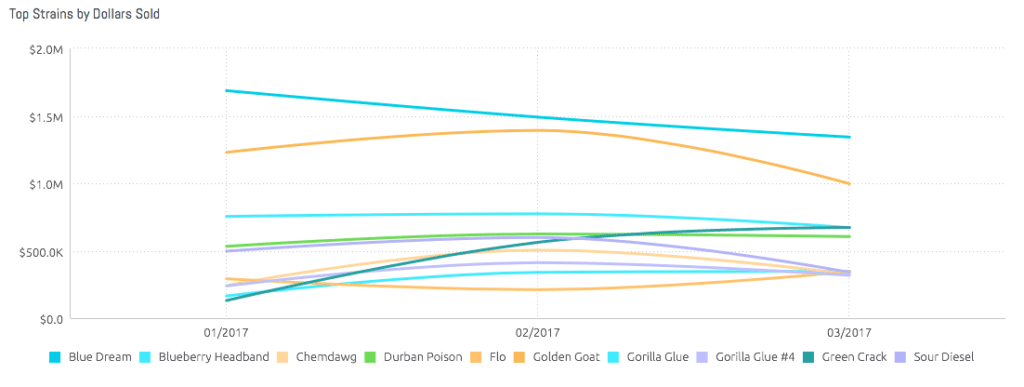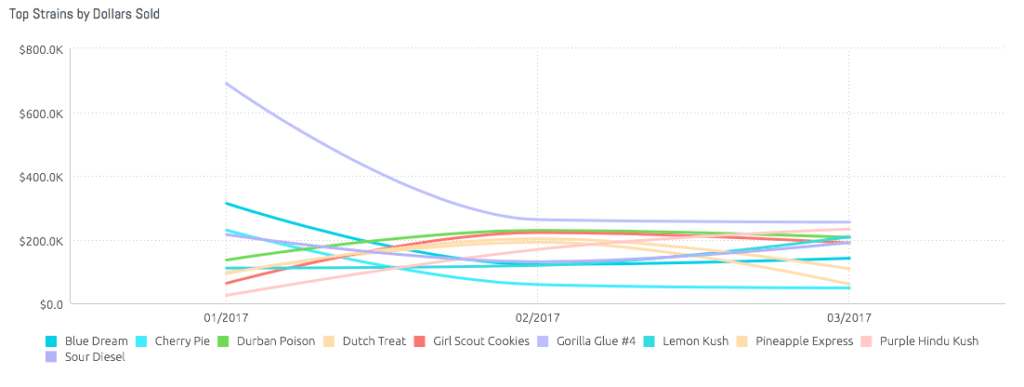The dispensary marketplace is a lively bazaar, with established brands and entrepreneurs every day coming up with new products — everything from chewing gums to nasal sprays to CBD-packed concentrates and massage lotions.
But the wide range of commercial innovations remain dwarfed, in terms of sales dollars and volume, by the thing that got this whole cannabis train chugging along these commercial tracks: flower.
During the first quarter of 2017 in Colorado and Oregon, and during January and February in Washington, flower grabbed 52 percent of the market on $313.9 million in sales. Concentrates’ market share was less than half of flower’s, at 24 percent, and edibles captured 13 percent.
The flower category may appear fairly monolithic — sales are represented largely by the buds sold in jars and pre-rolled joints — but activity within the behemoth is anything but staid. Most flower is sold as strains, like Purple Haze and White Widow. And consumers in different states largely go their own way when it comes to strain preferences.
Among Colorado, Washington and Oregon, only two strains — Blue Dream and Gorilla Glue — appear in the top 10 list of all three states, according to the market research firm BDS Analytics, which tracks more than 13,000 cannabis strains in its GreenEdge database.
Some strains that are enormously popular in one state — like Golden Goat in Colorado (the No. 2 strain during the first quarter, with $3,616,947 in sales) — do not even appear in the other states’ top 15 strains. Consumers in Washington during January and February, for example, spent enough on Super Lemon Haze to make it the No. 5 strain in state, but sales in Colorado and Oregon are not sufficient for the strain to break the top 15 barrier.
Meanwhile, Oregon bucks the other states when it comes to Blue Dream. That strain has been dominant in Colorado and Washington since both states introduced adult-use cannabis, but Oregonians prefer Gorilla Glue over Blue Dream; they spent more than twice as much on Gorilla Glue during the first quarter ($1,207,133) than they did on Blue Dream ($576,466).
Flower’s commercial effervescence takes place within states, as well as between them. Oregonians during the first quarter of 2017 were the most fickle. They went crazy for Gorilla Glue in January, when they dropped $694,321 on the strain compared to $293,722 for Blue Dream. But in March they spent just $254,704 on Gorilla Glue, while sales in March bumped Blue Dream down from No. 2 to 12th place.
Colorado customers were a bit more steady in their purchases, but Blue Dream has declined steadily since January, while Golden Goat rose and nearly beat Blue Dream before dropping back down again.
Sales in Washington during January and February have been nearly the same for all strains — the graph is a series of horizontal straight lines, with Blue Dream holding a commanding lead, followed by Green Crack, Gorilla Glue and Dutch Treat.
Strains are one of the many aspects of the cannabis industry that make the marketplace so very compelling. Instead of walking into dispensaries and purchasing generic and uniform “cannabis,” the dispensary experience is more akin to what consumers face in wine stores — yes, everything on the shelves comes from grapes, but that fruit offers a wild variety of flavors, aromas and experiences.



